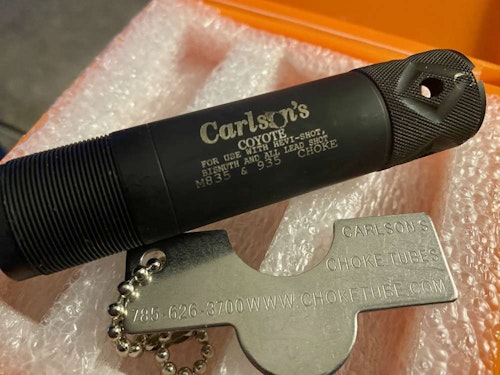
If you plan to hunt coyotes with shotguns, make sure to put in appropriate range time so you'll optimize the gun, ammo and choke tube. (Photo: Alan Clemons)
Patterning your shotgun for coyote hunting is as important as sighting-in a rifle for deer and elk or a shotgun for waterfowl and turkeys.
If you're going afield for anything, it's best to find out what works most effectively to take down your game in the best ethical manner. One shot, if possible. Wham, down. Dead right there.
Whether it's sighting a riflescope, as my co-worker and veteran hunter Dave Maas outlined here, or the sights or scope on a shotgun, plan ahead before going to the range. Sprawling across the truck hood and ripping off a few rounds at a soda bottle isn't the best way to find out what your shotgun can do. Make your range time count.
At the Range
Make sure your range gear is in order with targets, stands, a rangefinder to mark exact yardages, sandbags, a portable bench if you're not at an established range, and Sharpie pens (red and black) to make notes on the target.
For a realistic appearance, consider this coyote target from Birchwood Casey or the VisiColor 'yote target from Champion. I like to use a Lead Sled for a stable base; sandbags work with it to hold it down. MTM Case-Gard has a slew of cool, budget-friendly rests, tables and shooting accessories, too.
Which Ammunition?
It's tough to beat buckshot for coyotes. If you did your job at the range, a lethal pattern from buckshot can make coyotes take a tumble.
While hunting in Texas a couple of years ago I saw firsthand how effective Federal's Vital-Shok No. 4 buckshot works. Loaded into the Stevens 320 pump, an effective and value-priced shotgun, we roamed and called and knocked down songdogs at close range.
In one instance, four of us were nestled at the base of a tree. Two on one side, me on the other and longtime predator-chaser Mike Mattly calling like a champ. His Rocky Mountain Hunting Calls rabbit screamers were the deal. Mattly was standing, watching both sides. All the while, we scanned the mesquite, cactus and brush for any movement.
For whatever reason, I'd locked into where I thought a coyote might emerge. Instead of scanning back and forth with my eyes, I sat motionless watching one spot to my center-left. Stupid me. The coyote slipped in from my right and was less than 10 feet from me when I spied a flicker.
"Geeeehhhhahaaaaaaa what th' helllll?" came out in one big scream as the stunned coyote flinched, trotted about 30 feet away and stopped to look back. By this time I'd shouldered the shotgun and pulled the trigger. The buckshot rolled him. Mattly and my pals were laughing, of course.
"I can't believe you didn't see it," he said. "It almost jumped on you. You screamed like a girl."
Maybe so, but the buckshot worked.
I'll be putting the Vital-Shok in the rotation at the range, along with some Hornady Heavy Magnum Coyote. Out the 3-inch loads of BB or 00 buck and the No. 4 Federal buck, one should come out on top.
Word of caution: check with your state wildlife agency's laws or regulations about using buckshot. Some may have restrictions on ammuntion, even for predators.
Choke Tubes, of Course
If you have a shotgun that accepts screw-in chokes, bully for you. That's a leg up on different seasons and ammo, because you can switch out a choke tube and go after turkeys, coyotes, ducks or small game.

The average coyote stands about two feet tall. Its body is about half of that. In winter, thicker fur may make them appear bigger; in summer they'll be a little more scrawny. Either way, your vital target area is going to be about eight inches.
Does your shotgun throw a lethal pattern in 8-10 inches at 30 yards? How about 40 or 50? Sixty or 70? That's why range time is so important.
The choke tube constricts the shot at the muzzle before it exits the barrel. This constriction, combined with the ammo company's design of the shot wad, helps the shot develop into its pattern during flight. Makers of choke tubes, such as Carlson's, have specific tubes with different constrictions designed to handle lead, bismuth, Hevi-Shot or steel.
My Carlson's coyote tube is designed for my Mossberg 935. Carlson's says it throws dense patterns at 70 yards with larger loads. I haven't tested it at that range yet, but I will. My hunting spot is a mix of pasture and woods, so I need something to cover close and long range possibilities.
Want to see some close shotgun action? Watch the video below of Foxpro Hunting TV field-staffers Tom Austin and Richard Gonzales in northern Arizona picking up a quick double with suppressed scatterguns.





